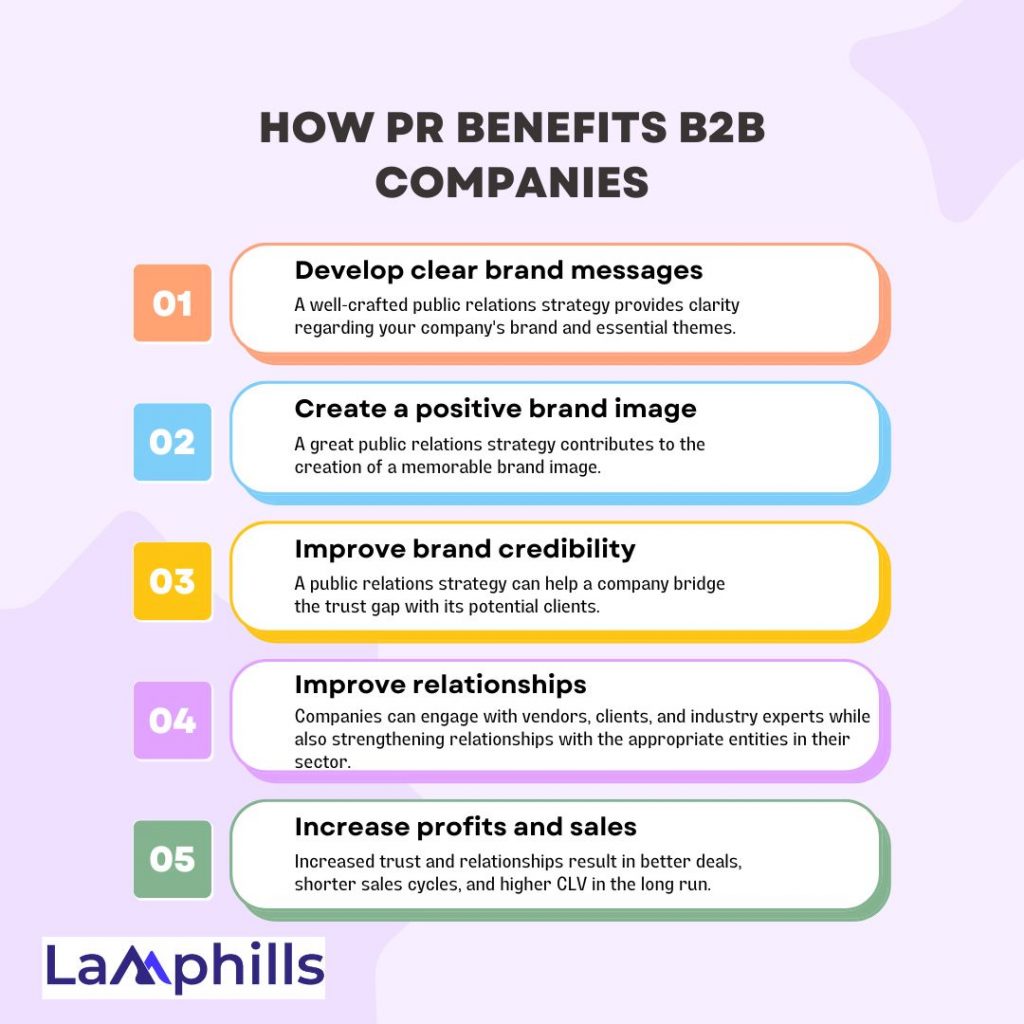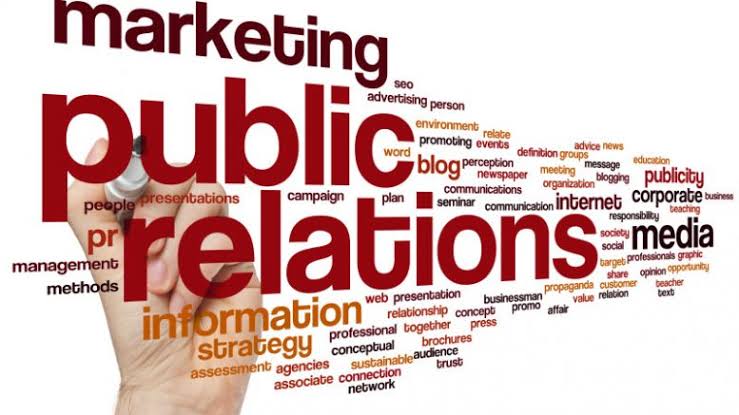When I first stepped into a busy conference room early in my PR career, I realized the unique problems and opportunities that B2B communication presents. I was responsible with bridging the gap between our technologically advanced company and traditional sectors that were unfamiliar with our products. This was more than simply public relations; it was about telling a tale that resonated on both a professional and a personal level, demonstrating the human side of B2B relationships. That event shaped my approach to B2B PR, which combines personal touch with professional understanding to influence how businesses perceive one another in the marketplace.
What is Business-to-Business Public Relations (B2B PR)?
B2B PR is a type of public relations that focuses on businesses that sell their products and services to other organizations rather than the general public.
PR for any organization is the proactive management of its reputation and communication process in order to increase favorable brand perceptions and trust among consumers and prospects.
In a nutshell, you want people to think and talk positively about your business. Today, familiarity is insufficient to sell; public relations keeps your brand at the forefront of consumers’ minds.
How can you do this correctly? Specialized B2B PR teams are comprised of industry experts with decades of expertise making companies that sell to other businesses well-known, loved, and trusted.
Key Takeaways
- Effective B2B public relations is not just about pushing out information; it’s about creating a narrative that resonates both professionally and personally, showing the human side behind business interactions.
- B2B PR requires crafting clear, culturally sensitive communications that are appropriate for diverse business audiences, which is vital for maintaining a positive reputation internationally.
- Navigating cultural differences, managing different time zones, and overcoming geographical distances are major challenges in international public relations.
- Success in international PR for B2B companies involves understanding global affairs, developing strong communication skills, and being adaptable to rapidly changing environments.
How Does PR Benefit B2B Companies?

Whether traditional or digital, a great public relations strategy can propel a brand to new heights. In addition to other business partners, it will enable companies to interact with customers, suppliers, investors, and other stakeholders who may help them grow.
B2B companies can use public relations as a strategy to:
#1. Develop clear brand messages
A well-crafted public relations strategy provides clarity regarding your company’s brand and essential themes. The top public relations professionals will assist you in distributing all of this information across multiple channels.
#2. Create a positive brand image
Nowadays, it is easy for a corporation to become lost in the crowd noise. So, a great public relations strategy contributes to the creation of a memorable brand image.
#3. Improve brand credibility
Earning clients’ trust is critical to your business’s success or failure, whether you’re just starting out or have grown into it. A public relations strategy can help a company bridge the trust gap with its potential clients.
#4. Improve relationships
Companies can engage with vendors, clients, and industry experts while also strengthening relationships with the appropriate entities in their sector.
#5. Increase profits and sales
Increased trust and relationships result in better deals, shorter sales cycles, and higher CLV in the long run.
Some people believe that public relations is limited to news releases and social media promotion. However, PR agencies can aid brands in the following areas:
- Positioning and messaging
- Communication techniques
- Content creation
- Event creation
- Product releases.
- Market Research
- Speech writing
- Employee Relations
- Thoughtful leadership
- Online reputation management
- Crisis Management
Read Also: Building an Effective Crisis Management Plan for Your Business
Top 9 Strategies for B2B PR Campaigns.
So, how can you create an effective B2B PR strategy? Check out the nine top B2B PR methods to help your firm succeed.
#1. Audience Research and Analysis
Audience research and analysis are important B2B public relations methods because they show the target market’s demands, preferences, and pain points. With this insight, B2B public relations professionals may adjust their messaging and content for maximum impact.
Creating buyer personas is an effective strategy for firms to gain insight into their target market’s mindset. What do they find engaging? What are their values? Marketing professionals may create B2B public relations initiatives that actually resonate with their target audience by humanizing them rather than viewing them as a monolith.
#2. Create Authoritative Content
Creating authoritative content is one of the most effective B2B PR techniques. It helps to establish a company’s reputation as an industry leader and expert. In fact, one of the numerous factors that Google considers before ranking a website is E-E-A-T, which stands for Experience, Expertise, Authority, and Trustworthiness.
In the competitive B2B landscape, building authority with high-quality, useful content fosters trust and shapes brand perceptions. Not to mention that authoritative material can gain media attention. Other sources will link back to your work, increasing your trustworthiness.
#3. Work With Influencers
Influencer marketing is an essential component of any good BRB PR strategy, leveraging the credibility and reach of industry experts and opinion leaders. Influencers can introduce a brand to a larger audience and significantly influence public opinion through their endorsements.
B2B organizations do a search for prospective influencers, examine their audiences, and then select the influencers who may be the best fit. Influencer marketing does not have to be prohibitively expensive. Identifying the correct influencers and carefully building an influencer marketing strategy may be extremely beneficial to your brand.
#4. Develop relationships with journalists
Journalists may be an extremely effective marketing tool for businesses. Making solid connections with journalists provides a direct line of communication with media organizations and publications. Finding journalists may be a difficult task for many firms, so keeping contacts as part of your B2B PR strategy can save a lot of time and effort.
Journalists may assist firms gain media attention and become go-to information sources. They can help your message travel much further and provide your brand consistent exposure.
#5. Use press release distribution platforms
Press release distribution systems enable brands to easily communicate critical corporate news and updates to a large audience. These platforms enable firms to access relevant audiences and get media attention.
Furthermore, if written correctly, press releases can appear on search engine results pages and news aggregators, increasing the brand’s visibility and authority.
Read Also: BEST FREE PRESS RELEASE DISTRIBUTION WEBSITES IN 2024
#6. Social Media & Online Presence
In 2024, having a strong social media and internet presence can make or ruin a corporation. Businesses can use social media to communicate directly and consistently with their target audience. Social media is more than just sharing cute animal videos. These important platforms are ideal for exchanging knowledge, building contacts, and demonstrating industry experience.
It’s worth mentioning that more than half of B2B buyers look up information on social media. If they can’t locate you readily, they’ll give up looking entirely. Arguably, social media is the foundation of B2B PR.
If a brand does not communicate with its audience for an extended period of time, it may lose their interest. No business wants to blend into the background. Companies may foster confidence and participate in crucial discussions by keeping active and relevant online.
#7. Use SEO in your public relations activities
When a company invests resources in developing high-quality content, it deserves to be recognized. SEO (Search Engine Optimization) enables potential customers and other stakeholders to discover a company’s content.
Businesses can improve their search exposure by optimizing their public relations materials for search engines. Appearing on the top page of Google can generate large quantities of organic traffic (traffic that you do not have to pay for!). Alternatively, not ranking at all can result in death.
#8. Increase the visibility of B2B video marketing initiatives
It’s no surprise that people increasingly favor visual content. However, too many brands ignore video content because they believe there will be minimal return. While videos need more effort to make than static photos, they enable firms to deliver complex concepts and display expertise.
Prospective customers can observe your product or service in action. A fascinating video can help a firm stand out from competitors who do not use video material.
#9. Host B2B events
We’ve discussed several internet tactics, but don’t underestimate the value of in-person relationship building. Hosting B2B events helps organizations engage with their target audience in-person or virtually, providing possibilities for networking, information sharing, and service promotion. Events can also raise firms’ knowledge of new opportunities, innovations, and gaps in the industry.
Early in my career, I created a public relations campaign for a company that specialized in cutting-edge cybersecurity solutions. We sent out press releases praising the technical features of their product, but the media response was lukewarm at best. The industry publications were inundated with similar pitches, and our message fell flat.
This experience prompted me to create the Industry Influencer Relationship Map. This approach enables us to discover and engage with the key journalists, analysts, and industry thought leaders who influence purchasing choices in our client’s target market.
Here’s the breakdown:
- Market Research: Determine which industry magazines, journalists, analysts, and influencers are most relevant to your target audience.
- Relationship Development: Create targeted outreach techniques to establish meaningful ties with industry leaders.
- Content Collaboration: Work together to generate informative content (articles, white papers, webinars) that will position your organization as an industry thought leader.
By following the Industry Influencer Relationship Map, you may build meaningful partnerships with the voices that are most important to your B2B audience.
How to Measure the Results of a B2B PR Campaign.
Making data-driven decisions is critical for any successful B2B PR strategy. Businesses should use crucial metrics like:
- Media mentions: Count how many times your brand is mentioned in media and publications. Be remember to bookmark these mentions for future promotion.
- Website Traffic: Monitor traffic increases caused by public relations operations using Google Analytics or other platforms.
- Lead generation: Track the number of leads generated by public relations initiatives such as content downloads, form fills, phone calls, or webinar registrations.
- KPI Monitoring: Monitor interaction indicators on social media networks, such as likes, shares, comments, and followers.
- Customer surveys: Conduct surveys to assess customer perceptions and sentiments following public relations activities.
- Online reputation: Use sentiment analysis techniques to learn how your brand is perceived.
- ROI Analysis: Calculate return on investment (ROI) by comparing the costs of public relations initiatives to the revenue earned.
Benchmarking your public relations performance against that of competitors can help you uncover areas for development and differentiation.
These metrics provide firms with vital insights into the effectiveness of their B2B public relations campaigns. With these insights, firms may make data-driven decisions to improve their future B2B PR efforts.
Why You Should Partner With a B2B Public Relations Agency
Remember, you don’t have to do this alone! Any B2B PR marketing firm may agree that relying on help is the greatest way to minimize burnout and enhance performance. It’s like the saying goes: work smarter, not harder.
Partnering with a B2B digital marketing agency can significantly improve your B2B public relations. BRB PR agency, comprised of skilled specialists, have a wealth of knowledge and connections. By partnering with an agency, firms can save up time from creating and preparing time-consuming B2B PR campaigns, allowing them to focus on other important activities.
Conclusion
Understanding your B2B audience’s specific demands and pain areas, as well as developing relationships with industry influencers, allows you to create compelling narratives that appeal to decision-makers.
Effective B2B PR is much more than just raising awareness. It’s about establishing your organization as a trustworthy partner throughout the difficult B2B purchasing process.
So, are you ready to harness the full power of B2B PR and transform your brand into a magnet for qualified leads? What hurdles have you encountered in your B2B public relations efforts? Please share your experiences in the comments below!
Lamphills can assist you in developing a strategy B2B public relations plan, identifying and connecting with key industry influencers, and creating data-driven stories that highlight the value your firm adds to the B2B marketplace. Are you ready?
Related Articles
- Best PR Firms: Discovering the Powerhouses Behind Brand Success.
- HOW TO CREATE A PRESS KIT WITH EXAMPLES AND FREE TEMPLATES
- Best Steps To Effective PR Crisis Management
- How To Send a Press Release: Your Personal Guide to Making Waves in the Media
- How To Turn off Business Account On Instagram






